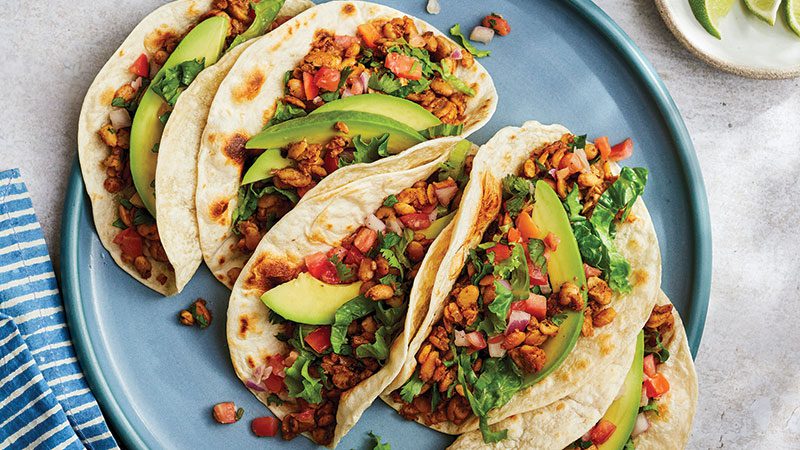Soybean Time Travel
By Cynthia Lair, guest contributor
This article was originally published in September 2023
Soybeans were first cultivated for human food in 11th century China. A gift from Chinese travelers, they made their way to the U.S. in the 1700s but didn’t gain much traction. The beans were an anomaly, used for example as a coffee substitute for Civil War soldiers. They were not considered a main food source for people in the U.S. until the 20th century when farmers found a very clever workaround for getting this cheap resource into human bodies—using the crop as feed for livestock. Soybeans quickly became irreplaceable—though not with the “health food” aura they later acquired—as scientists and food manufacturers found ways to refine the beans into generic salad oil, margarine and baby formula. Soy oil proved to be handy too, for making non-food items, such as crayons, cosmetics, pet food, soap and detergents. This innovation and versatility prompted the nation to embrace more and more acres of soybean growth. The U.S. was producing almost 4 billion bushels of soybeans per year at the beginning of the 21st century.
The popularity of the bean grew exponentially during the 1960s and ’70s in America, and became more widely seen as a wise menu choice. This boom was spurred by several factors. New studies warned that eating too much cholesterol-containing foods could lead to heart disease. Eating less meat and fewer eggs was recommended. Simultaneously, the counter-culture of the ’70s embraced less-processed foods as a virtue. Feedlot-produced meat was (still is) questioned because of its environmental and humanitarian concerns. “Diet for a Small Planet” (1971) sparked a dietary revolution, and numerous classic vegetarian cookbooks like “The Vegetarian Epicure” (1972), “The Moosewood Cookbook” (1977) and “Laurel’s Kitchen” (1986) came forward and became bestsellers representing the natural foods movement. A star source of protein during this shift was low-cost, easy-to-grow soy. “The Joy of Soy” became a popular class as part of the PCC Cooks schedule. Riding this aura of healthfulness, the food industry went full steam ahead in the ’80s and ’90s into processed pursuits of variable nutritional benefits, finding takers for soymilk, soy ice cream, veggie burgers, soy-protein energy bars, and soy protein powders made from soy protein isolate and texturized vegetable protein (these ingredients can’t be made in your kitchen!).
Phytic acid can interfere with mineral absorption
The pros of including soy in the diet are admirable still today. Along with its non-animal protein contributions, soybeans give us B vitamins, fiber, potassium, magnesium and essential fatty acids. On the flip side, soybeans can be difficult to digest. Trypsin inhibitors, which can interfere with protein digestion, and phytoestrogens, whose benefits are debatable, are part of the soybean package. Soybeans also have the highest phytate level of any grain or bean. Phytic acid can interfere with mineral absorption, particularly zinc, but also calcium, magnesium and iron by blocking uptake in the gut.
When the nutritional pros and cons begin to blur, time traveling may prove enlightening. Miso and shoyu trace their origins to 7th century China and further evolved as the paste made its way to Japan. Indonesia lays claim to the invention of tempeh in the 1600s. These food cultures, the ones that originally weaved soybeans into the human diet, fermented the bean by adding live cultures. The long fermentation period breaks down the components that are otherwise difficult to digest. This is similar to how fermentation makes gluten easier to digest if breads are sourdough-based; and to how cow’s milk gets a digestive boost if cultured into yogurt. Phytic acid is also reduced during the fermentation process, making the bean’s array of minerals more bioavailable. Ancient Asian cultures traditionally consumed soy with mineral-rich sea vegetables or fish broth, which balances the potential for mineral malabsorption or potential thyroid dysfunction resulting from a diet heavy on soy products. In my years of teaching, for Bastyr University and the PCC Cooks program, our focus on eating fermented soy in more traditional dishes seemed not only prudent, but tasty.
Tasty is important! Tasty is good! The body responds favorably when our food has an appealing flavor. Less so to sustenance tolerated for health reasons. A bowl of soothing miso soup made with homemade dashi stock is a celebration of the bean’s flavor not to be compared with a smoothie laced with protein powder, where the soy food is tasteless background noise.
While individual recipes may not prove timeless, Michael Pollan’s concise advice—“Eat food. Not too much. Mostly plants” continues to ring true as a message that began with the mid-20th century natural food movement. As PCC hits its 70th anniversary milestone, we are grateful that Seattle responded to the “back-to-nature” call of true believers with a humble little food co-op.


